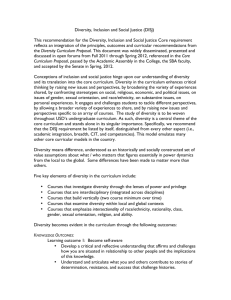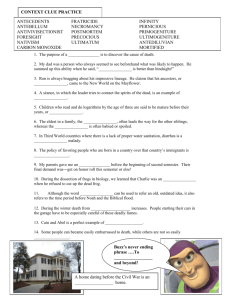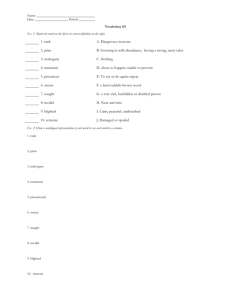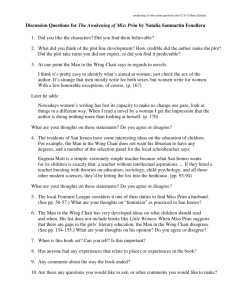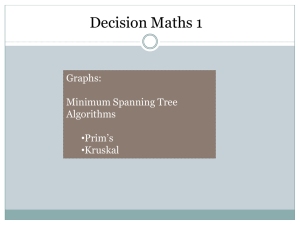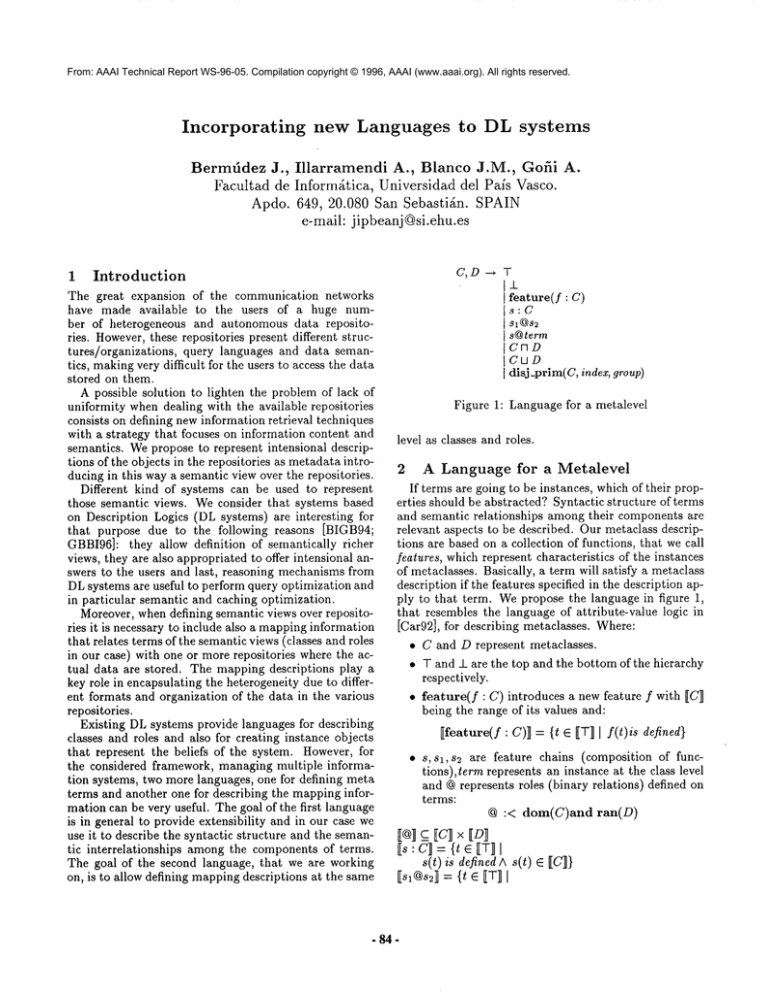
From: AAAI Technical Report WS-96-05. Compilation copyright © 1996, AAAI (www.aaai.org). All rights reserved.
Incorporating
new Languages
to DL systems
Bermfidez J., Illarramendi
A., Blanco J.M., Gofii
Facultad de Inform£tica,
Universidad del Pals Vasco.
Apdo. 649, 20.080 San Sebasti£n.
SPAIN
e-maih jipbeanj @si.ehu.es
1
Introduction
The great expansion of the communication networks
have made available
to the users of a huge number of heterogeneous and autonomous data repositories. However,these repositories present different structures/organizations,
query languages and data semantics, makingvery difficult for the users to access the data
stored on them.
A possible solution to lighten the problem of lack of
uniformity when dealing with the available repositories
consists on defining new information retrieval techniques
with a strategy that focuses on information content and
semantics. Wepropose to represent intensional descriptions of the objects in the repositories as metadata introducing in this way a semantic view over the repositories.
Different kind of systems can be used to represent
those semantic views. Weconsider that systems based
on Description Logics (DL systems) are interesting for
that purpose due to the following reasons [BIGB94;
GBBI96]: they allow definition of semantically richer
views, they are also appropriated to offer intensional answers to the users and last, reasoning mechanisms from
DLsystems are useful to perform query optimization and
in particular semantic and caching optimization.
Moreover, when defining semantic views over repositories it is necessary to include also a mappinginformation
that relates terms of the semantic views (classes and roles
in our case) with one or more repositories where the actual data are stored. The mapping descriptions play a
key role in encapsulating the heterogeneity due to different formats and organization of the data in the various
repositories.
Existing DL systems provide languages for describing
classes and roles and also for creating instance objects
that represent the beliefs of the system. However, for
the considered framework, managing multiple information systems, two more languages, one for defining meta
terms and another one for describing the mapping information can be very useful. The goal of the first language
is in general to provide extensibility and in our case we
use it to describe the syntactic structure and the semantic interrelationships
among the components of terms.
The goal of the second language, that we are working
on, is to allow defining mappingdescriptions at the same
A.
C, n -’+
I
feature(f : C)
s:C
sl@s2
s@term
CnD
CUD
disj_prlm(C, index, group)
Figure 1: Language for a metalevel
level as classes and roles.
2
A Language
for a Metalevel
If terms are going to be instances, which of their properties should be abstracted? Syntactic structure of terms
and semantic relationships amongtheir components are
relevant aspects to be described. Our metaclass descriptions are based on a collection of functions, that we call
feaLures, which represent characteristics of the instances
of metaclasses. Basically, a term will satisfy a metaclass
description if the features specified in the description apply to that term. Wepropose the language in figure 1,
that resembles the language of attribute-value logic in
[Car92], for describing metaclasses. Where:
* C and D represent metaclasses.
¯ T and _L are the top and the bottom of the hierarchy
respectively.
¯ feature(f: C) introduces a new feature f with [[C1]
being the range of its values and:
~feature(f : C)~ = {t E [[T~l f(t)is
defined}
¯ s, sl,s2 are feature chains (composition of functions),term represents an instance at the class level
and @represents roles (binary relations) defined
terms:
@ :< dom(C)and ran(D)
[8:c = {t E F]I
- 84 -
s(t) is defined A s(t) ~
STATE=
disj_prIm(CONCEPT_TERM,
state, sort)
ACTION =
disj_prlm(CONCEPT_TERM rq
feature(start:
STATE)
feature(end:STATE)
feature(add: STATE)[q
feature(delete: STATE),action, opr)
SCENARIO =
disj_prim(T, scenario, term)
SINGLE =
disj_prim(SCENARIO [q
feature(act : ACTION),
single, opr)
SEQUENCE =
disj_prim( SCENARIO
[q
feature(]st: SCENARIO)
[q
feature(snd : SCENARIO),
seq, opt)
CONCEPT_TERM =
disj_prim(T, concept_term, term)
ROLE_TERM =
disj_prim(T, role_term, term)
ROLE_REST=
CONCEPT_TERM n
feature(role:ROLE_TERM)
RANGE_REST =
ROLE_REST n
feature(concept:CONCEPT_TERM)
NUMERIC=
disj_prim(T, numeric, term)
NUMBER_REST =
ROLE_RESTrl
feature(num:
NUMERIC)
ATLEAST =
disj_prim(NUMBER_REST,
atleast, opr)
ATMOST =
dlsj_prim(NUMBER_REST,
atmost, opt)
ALL =
disj_prim(RANGE_REST,
all, opt)
ALL_REST =
ALL R num¯ concept:INTERVAL
Furthermore, roles can be attached to metaclasses. For
example, the subsumption relationship
between terms
could be defined as a role attached to T.
E_ :< dora(T) andran(T)
but other relationships could also be interesting.
For example interschema and intraschema assertions in
[CL93]. Subsumption on this metalevel depends on the
semantics of (@) roles attached to metaclasses.
Figure 2: Metaclasses
sl(t), s2(t) are defined A (sl(t),
[Is@term] = {t E IT] I
s2(t)) E [@]]}
3
s(t) defined^ (dr), term[@
]}
[CFI D] = Cn D
[Ct_l D] = CUD
[disj_prim(C, index, group)]] C_ [C]
¯ disj_prim(C, index, group) defines primitive metaclasses and pairwise disjoint with those of the same
roup parameter (the same operator as in CLASSIC
MPS+91].
fB
Notice that the usual class level becomesnowan instance
level too. With this language we can define metaclasses
so that any term provided by DL systems will be an
instance of them (see figure 2).
Fromthis point of view, a language for the definition
of terms is an assertional language at the class level. For
example, the definition of the term:
t := all(r, atmost(n, s))
asserts the following:
t :: ALLF1 concept : ATMOST
and:
role(t)
num.concept(t)
role.concept(t)
=
=
=
Language
for
information
describing
a mapping
As mentioned before, an important aspect when coupling different types of systems (DL systems and heterogeneousrepositories in our case) is the definition of the
mapping information. However, mapping languages are
not described in detail in the literature. Weare working on mapping descriptions that subscribe to the idea
of viewing a data repository as a set of entities and attributes, independently of the concrete organization of
the data in the repository. Attributes play a central
role. Weassume there exists an equivalence relationship defined on them, formalizing their semantic equivalence. Therefore we can take representative attributes
as unique up to semantic equivalence. Weadvocate for
these attributes being the coordinates of a high dimension vectorial space. Every set of attributes defines a
subspace. Each mapping description specifies its corresponding subspace; meaning that the entities they support are identified just by these attributes. Whenthe
repository is a relational database, subspace descriptions
may include functional dependencies among attributes.
Mappingdescriptions are tuple sets descriptions. They
are expressed with a propositional formula that represents a relational algebra expression, in the following
way:
¯ Every base relation is associated with a propositional constant.
Moreover, new kind of terms can be added naturally,
for example CLASPterms [Bor92] defined to represent
classes of actions and plans:
¯ A select operation on the relation associated with P
is represented by P A f where f is a propositional
constant that represents the selection condition.
- 85 -
¯ Union, intersection and difference are represented
by P V Q, P A Q, P A --,Q respectively.
All these operations give relations within the same subspace, and propositional formulae implication implies relation inclusion. Inverse implication cannot be guaranteed. Cartesian product renders a relation inside the
subspace specified with the union of their attributes (i.e.
coordinates) and then receives its associated propositional constant. Conjoining a propositional formula to a
subspace focuses on the desired attributes.
Next we show metalevel terms whose instances are
mapping descriptions:
MAPPING_TERM -disj_prim(T, mapping_term, term)
MAP =
disj_prim(MAPPING_TERM
feature(space:ATTRIBUTES)
feature(constraint
: PROP_FORMULA),
map, opr)
Notice that the notion of subsumption in this context involves sets of attributes. A mapping description
map(A, a) subsumes another one map(B,/3)
¯ACB.
[Bor92]
[Car92]
[CL93]
[GBBI96]
The attributes needed to identify the different instances represented by a is a subset of the attributes
needed to identify those represented by t3. That is,
B can be considered as a superkey for A.
@ /~ ----~
Ot
Moreover, the role supporter:
<J :< dora(CONCEPT_TERM)
and ran(MAPPING_TERM)
relates classes with the repositories where the actual data
are stored.
Finally, once we have a language to describe a mapping
information it results very interesting to provide a query
language that allows formulating queries such as:
CONCEPT_TERM
R ~ <1 map(A, c~)
(~ represents the empty chain)
The answer to that query could be useful for one interested in knowingthe repercussions of the deletion operation of attributes in A.
References
[BIGB94] J.M. Blanc¯, A. Illarramendi, A. Gofii, and
J. Bermfidez. Advantages of using a terminological system for integrating databases.
In Proc. of the International Workshop on
Description Logics. Bonn. Germany, 1994.
[BMPS+91] R.J.
Brachman,
D.L.
McGuiness, P.F. Patel-Schneider, L.A. Resnick,
and A. Borgida. Living with CLASSIC:
When and how to use a KL-ONE-like language. In Principles of Semantic Networks
- 85 -
(J.F. Sowa ed.), pages 401-456. Morgan
KaufmannPub. Inc., 1991.
A. Borgida. Towards the systematic development of description logic reasoners:
CLASPreconstructed. In Proc. of Principles of Knowledge Representation and Reasoning (KR’92), pages 259-269, 1992.
Bob Carpenter. The Logic of Typed Feature
Slructures. Cambridge University Press,
1992.
T. Catarci and M. Lenzerini. Representing
and using interschema knowledge in cooperative information systems. International
Journal of Intelligent and Cooperative Information Systems, 2(4):375-398, 1993.
A. Gofii, J. Bermddez, J.M. Blanc¯, and
A. Illarramendi.
Using reasoning of description logics for query processing in
multidatabase systems. In Proc. of the
Knowledge Representation meets Databases
(KRDB ’96) in ECAI ’96. Budapest (Hungary), 1996.

